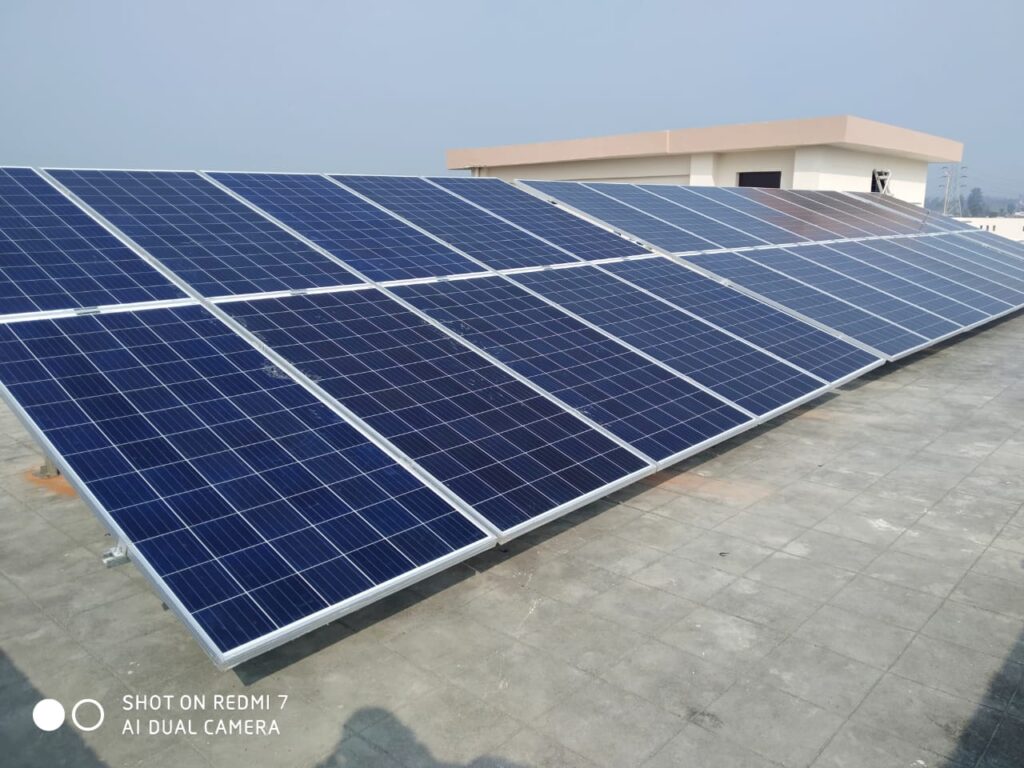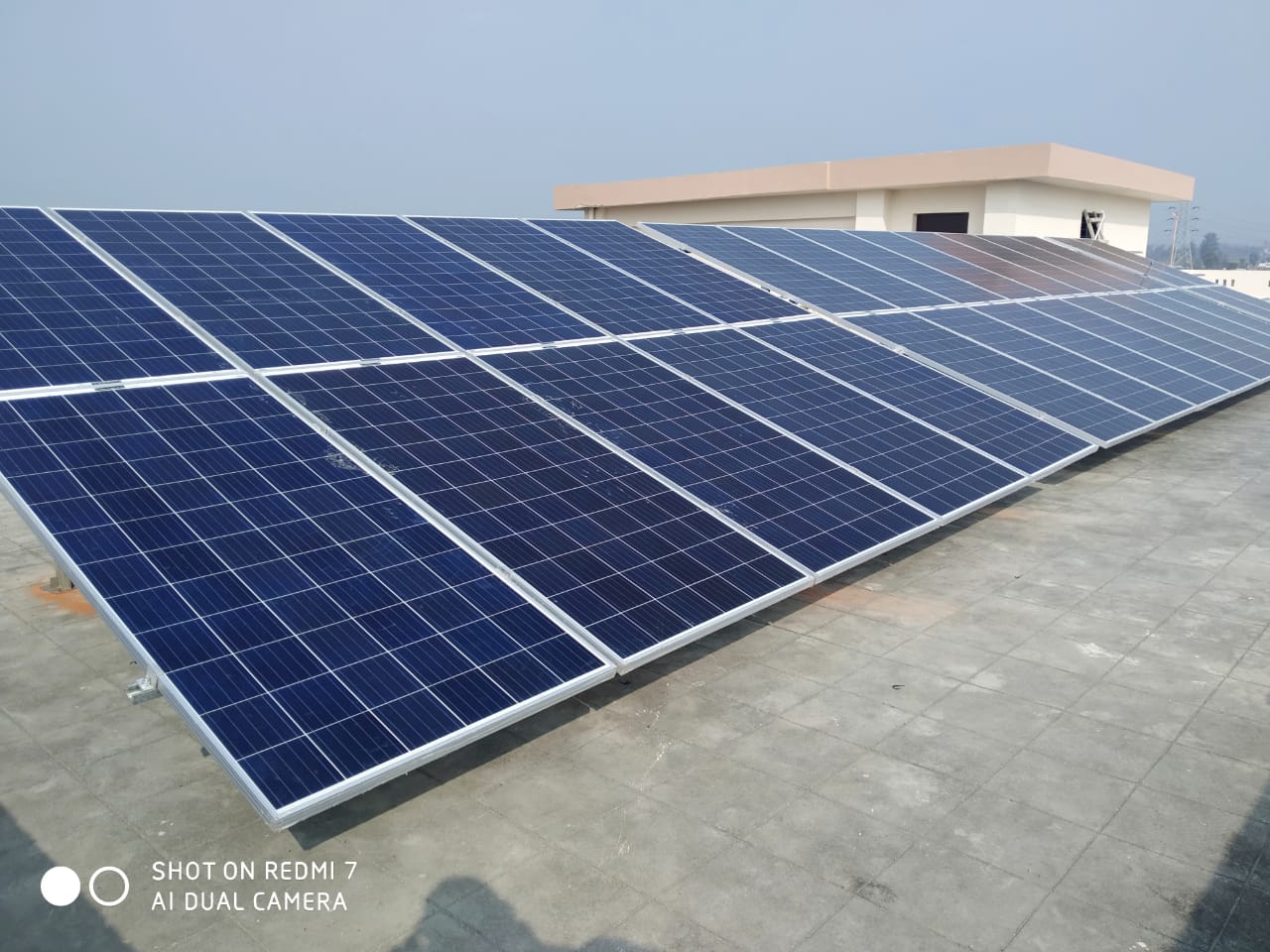SOLAR SYSTEMS

Solar power, also known as solar electricity, is the conversion of energy from sunlight into electricity, either directly using photovoltaic’s (PV) or indirectly using concentrated solar power. Solar panels use the photovoltaic effect to convert light into an electric current. Concentrated solar power systems use lenses or mirrors and solar tracking systems to focus a large area of sunlight to a hot spot, often to drive a steam turbine.
Photovoltaics were initially solely used as a source of electricity for small and medium-sized applications, from the calculator powered by a single solar cell to remote homes powered by an off-grid rooftop PV system. Commercial concentrated solar power plants were first developed in the 1980s. Since then, as the cost of solar panels has fallen, grid-connected solar PV systems‘ capacity and production has doubled about every three years. Three-quarters of new generation capacity is solar, with both millions of rooftop installations and gigawatt-scale photovoltaic power stations continuing to be built.
In 2023, solar generated 5% of the world’s electricity compared to 1% in 2015, when the Paris Agreement to limit climate change was signed. Along with onshore wind, in most countries, the cheapest levelised cost of electricity for new installations is utility-scale solar.
Almost half the solar power installed in 2022 was rooftop. Much more low-carbon power is needed for electrification and to limit climate change. The International Energy Agency said in 2022 that more effort was needed for grid integration and the mitigation of policy, regulation and financing challenges.
Geography affects solar energy potential because different locations receive different amounts of solar radiation. In particular, with some variations, areas that are closer to the equator generally receive higher amounts of solar radiation. However, solar panels that can follow the position of the Sun can significantly increase the solar energy potential in areas that are farther from the equator. Daytime cloud cover can reduce the light available for solar cells. Besides, land availability has a large effect on the available solar energy.

Photovoltaic cells
A solar cell, or photovoltaic cell, is a device that converts light into electric current using the photovoltaic effect. The first solar cell was constructed by Charles Fritts in the 1880s. The German industrialist Ernst Werner von Siemens was among those who recognized the importance of this discovery. In 1931, the German engineer Bruno Lange developed a photo cell using silver selenide in place of copper oxide,
although the prototype selenium cells converted less than 1% of incident light into electricity. Following the work of Russell Ohl in the 1940s, researchers Gerald Pearson, Calvin Fuller and Daryl Chapin created the silicon solar cell in 1954. These early solar cells cost US$286/watt and reached efficiencies of 4.5–6%. In 1957, Mohamed M. Atalla developed the process of silicon surface passivation by thermal oxidation at Bell Labs. The surface passivation process has since been critical to solar cell efficiency.
As of 2022 over 90% of the market is crystalline silicon. The array of a photovoltaic system, or PV system, produces direct current (DC) power which fluctuates with the sunlight’s intensity. For practical use this usually requires conversion to alternating current (AC), through the use of inverters. Multiple solar cells are connected inside panels. Panels are wired together to form arrays, then tied to an inverter, which produces power at the desired voltage, and for AC, the desired frequency/phase.
Many residential PV systems are connected to the grid wherever available, especially in developed countries with large markets. In these grid-connected PV systems, use of energy storage is optional. In certain applications such as satellites, lighthouses, or in developing countries, batteries or additional power generators are often added as back-ups. Such stand-alone power systems permit operations at night and at other times of limited sunlight.
In “vertical agrivoltaics” system, solar cells are oriented vertically on farmland, to allow the land to both grow crops and generate renewable energy. Other configurations include floating solar farms, placing solar canopies over parking lots, and installing solar panels on roofs.

Thin-film solar
A thin-film solar cell is a second generation solar cell that is made by depositing one or more thin layers, or thin film (TF) of photovoltaic material on a substrate, such as glass, plastic or metal. Thin-film solar cells are commercially used in several technologies, including cadmium telluride (CdTe), copper indium gallium diselenide (CIGS), and amorphous thin-film silicon (a-Si, TF-Si).
Perovskite solar cells
A perovskite solar cell
(PSC) is a type of solar cell that includes a perovskite-structured compound, most commonly a hybrid organic–inorganic lead or tin halide-based material as the light-harvesting active layer. Perovskite materials, such as methyl ammonium lead halides and all-inorganic cesium lead halide, are cheap to produce and simple to manufacture.
Solar-cell efficiencies of laboratory-scale devices using these materials have increased from 3.8% in 2009 to 25.7% in 2021 in single-junction architectures, and, in silicon-based tandem cells, to 29.8%, exceeding the maximum efficiency achieved in single-junction silicon solar cells. Perovskite solar cells have therefore been the fastest-advancing solar technology as of 2016. With the potential of achieving even higher efficiencies and very low production costs, perovskite solar cells have become commercially attractive. Core problems and research subjects include their short- and long-term stability.
Hybrid systems
A hybrid system combines solar with energy storage and/or one or more other forms of generation. Hydro, wind and batteries are commonly combined with solar. The combined generation may enable the system to vary power output with demand, or at least smooth the solar power fluctuation. There is a lot of hydro worldwide, and adding solar panels on or around existing hydro reservoirs is particularly useful, because hydro is usually more flexible than wind and cheaper at scale than batteries, and existing power lines can sometimes be used.
Concentrating solar power stations
Commercial concentrating solar power (CSP) plants, also called “solar thermal power stations”, were first developed in the 1980s. The 377 MW Ivanpah Solar Power Facility, located in California’s Mojave Desert, is the world’s largest solar thermal power plant project. Other large CSP plants include the Solnova Solar Power Station (150 MW), the Andasol solar power station (150 MW), and Extresol Solar Power Station (150 MW), all in Spain. The principal advantage of CSP is the ability to efficiently add thermal storage, allowing the dispatching of electricity over up to a 24-hour period. Since peak electricity demand typically occurs at about 5 pm, many CSP power plants use 3 to 5 hours of thermal storage.

